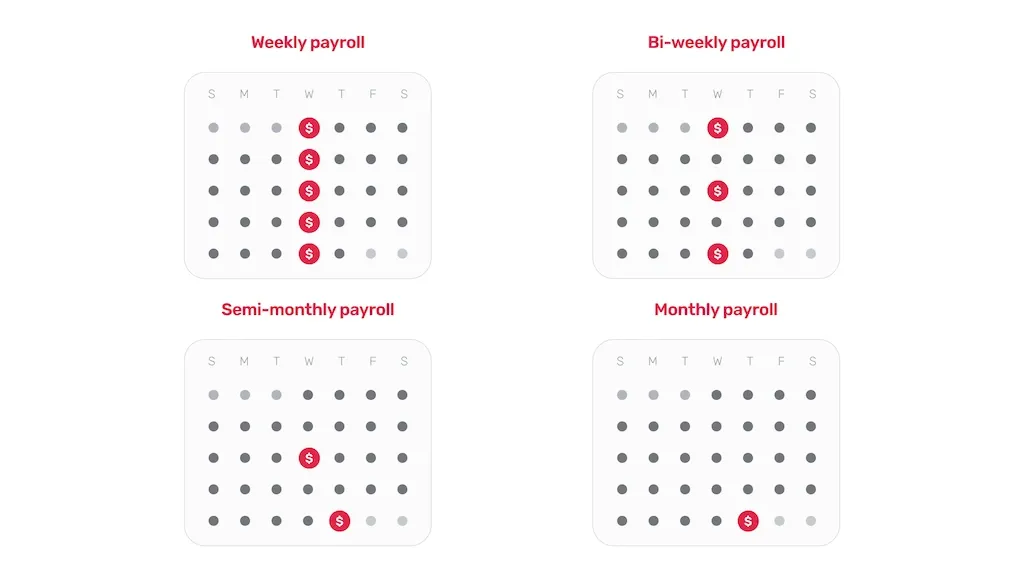How Many Pay Periods in a Year? A Guide for Employers
Running payroll doesn’t just mean sending money to employees. It’s about consistency, compliance, and cash flow. One of the most important decisions you'll make is how often your team gets paid. Whether you're just starting or reviewing your existing payroll system, understanding how many pay periods occur in a year is essential for proper planning.

What is a pay period?
A pay period is a recurring schedule that determines how often employees are paid. It also affects how payroll taxes are calculated, how employee benefits are accrued, and how financial planning is structured for both employers and employees.
Understanding pay periods: weekly, bi-weekly, semi-monthly and monthly
Each pay period comes with its advantages and drawbacks. Below is a breakdown of the most common payroll frequencies.

Weekly pay period (52 pay periods per year and 53 in a leap year)
A weekly pay period means employees are paid once every week, typically on the same weekday (e.g., every Friday). This results in 52 pay periods in a standard year, but occasionally 53 in a leap year, depending on how the calendar falls.
Best suited for: Hourly workers, gig workers, or industries such as hospitality and construction, where employees benefit from regular cash flow.
Biweekly pay period (26 or 27 pay periods in a year)
A biweekly pay period means employees are paid every two weeks, usually on the same day of the week (e.g., every other Friday). This results in 26 pay periods per year, with the possibility of 27 in leap years due to the way the calendar aligns.
Best suited for: Both hourly and salaried employees; commonly used in the US and other countries due to its balance of frequency and administrative ease.
Semi-monthly pay periods (24 pay periods in a year)
A semi-monthly pay period involves two payments per month, typically on fixed dates, such as the 15th and the last day of the month, resulting in 24 pay periods per year.
Best for: Salaried employees with stable incomes; businesses looking to align payroll with monthly accounting and benefit cycles.
Monthly pay periods (12 pay periods in a year)
With a monthly pay period, employees are paid once a month, typically on a fixed date, such as the 30th or the last business day of the month. This results in 12 pay periods per year.
Best for: Salaried roles, senior professionals, or businesses with low administrative resources.
| Pay period | Paychecks per year | Description | Pros | Cons |
| Weekly | 52 (53 in a leap year) | Employees are paid once every week, typically on the same day (e.g., every Friday). | - Frequent payments can help employees better manage weekly expenses. - Motivating for hourly and gig workers who rely on quick income. - Easier to calculate overtime based on weekly limits. | - Increases administrative workload significantly. - More costly for payroll processing and reporting. - Can complicate tax and benefits calculations. |
| Bi-weekly | 26 (occasionally 27) | Employees are paid every other week, typically on the same weekday (e.g., every other Friday). | - Popular with both salaried and hourly employees. - Still offers regular cash flow. - Overtime is easier to manage than semi-monthly. - Balanced in terms of admin effort and employee satisfaction. | - Not aligned with calendar months, which may make deductions for benefits and taxes more complex. - Some years will have 27 pay periods, which may require adjustments to salaries or budgeting. |
| Semi-monthly | 24 | Employees are paid twice a month, usually on fixed dates (e.g., the 15th and 30th). | - Aligns well with monthly accounting and benefit contributions. - Ideal for salaried employees with predictable schedules. - Reduces admin time compared to weekly or bi-weekly pay. | - A variable day of the week can confuse hourly staff. - Overtime calculations can be complex. - If payday falls on a weekend or holiday, payments must be rescheduled. |
| Monthly | 12 | Employees are paid once a month, typically on the same date (e.g., the 30th or last working day). | - Easiest for employers to administer and budget. - Simplifies benefit contributions and deductions. - Often used for senior salaried staff or small businesses. | - Least frequent pay period; not ideal for employees living paycheck to paycheck. - May cause budgeting challenges for employees. - Not recommended for hourly workers or those with variable schedules. |
Key considerations at a glance
Choosing the right pay schedule isn't just about convenience. It's about balancing employee needs, administrative efficiency, and financial planning. Here's a quick comparison of the most common pay periods to help you decide what fits best for your business.
Pay period | Paychecks per year | Best for | Admin burden | Employee preference |
| Weekly | 52 (or 53) | Hourly/gig workers | High | Very high |
| Bi-weekly | 26 (or 27) | Salaried/hourly employees | Moderate | High |
| Semi-monthly | 24 | Salaried employees | Low | Moderate |
| Monthly | 12 | Salaried employees | Very low | Low |

Choosing the right pay period for your business
There’s no one-size-fits-all solution; the proper pay schedule depends on your business’s structure and needs.
Employee type
Hourly employees may benefit from weekly or bi-weekly payments, while salaried workers typically manage well with semi-monthly or monthly pay.
Administrative resources
Smaller teams with limited HR and finance staff may prefer less frequent pay runs to reduce processing time.
Cash flow
More frequent payroll means cash leaves your account more often. Consider your business’s cash flow cycle before making a commitment.
Legal compliance
Some countries or states have laws that dictate the minimum pay frequency, especially for hourly workers. Make sure to stay compliant.
Industry norms
Your payroll frequency may also be influenced by standard practices in your industry. For example, the construction industry often follows a weekly pay schedule.

How about leap years and 27 pay periods?
In leap years, a bi-weekly schedule may result in 27 pay periods instead of 26. Employers must plan for this extra payment to ensure budgets, benefit deductions, and tax calculations remain accurate. Transparent communication with employees about any payroll anomalies is also key.
How to transition to a new pay period?
Switching payroll frequencies requires careful planning:
- Inform employees well in advance
- Adjust employment contracts and internal systems
- Recalculate pro-rata salaries and benefits
- Coordinate with your payroll provider for a smooth shift
Looking to simplify this transition? Native Teams offers expert Payroll Management to support every step of the way.
What happens when paydays fall on weekends or holidays?
If a payday lands on a non-business day, employers must process payment either before or after the actual date, depending on local labour laws and internal policy. Failing to adjust may result in penalties or employee dissatisfaction.
Impact on taxes and benefits
The number of pay periods in a year directly affects:
- Withholding calculations for income tax, social contributions, and benefits
- Benefit accruals like paid leave or pension
- Annual limits on contributions or deductions (e.g., bonuses, insurance)
Choosing the wrong pay schedule or mishandling deductions can lead to compliance issues.

Let Native Teams handle your payroll
Choosing and managing your payroll schedule doesn't have to be stressful. Native Teams offers fully compliant payroll and HR solutions tailored for businesses with remote or global teams. From choosing the best pay cycle to handling cross-border payments, we've got you covered. Discover more about our Payroll Management and Employer of Record services today.
Key Takeaways
- There are typically 52 weekly, 26 bi-weekly, 24 semi-monthly, or 12 monthly pay periods in a year, but leap years can add an extra pay cycle.
- Each pay frequency has its pros and cons, depending on the employee type, administrative capacity, and cash flow.
- A well-chosen pay period enhances employee satisfaction and simplifies financial planning.
- Be mindful of legal compliance and extra pay periods in leap years.
- Native Teams can help automate payroll and ensure global compliance.
